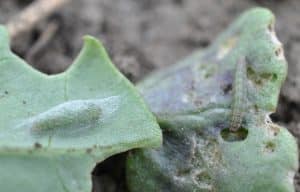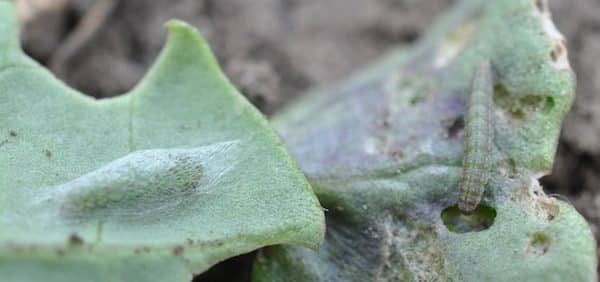Diamondback moth. Larvae have been found feeding on young canola plants, but to date these cases are few and far between. First instar diamondback moth larvae are leaf miners, feeding on green tissue inside the leaves and leaving behind the outer epidermis, causing a “windowpane” effect. Older larvae usually feed on leaf undersides. Damage to young canola plants by diamondback moth larvae rarely warrants insecticide control as populations are seldom high enough to cause economic injury until the pod development stage. Early arrival: Diamondback moths don’t usually overwinter in Western Canada. New adult populations blow in each year on winds from the south and lay eggs soon after arrival. Some traps in Alberta and Manitoba suggest elevated risk. But while larvae have been found in some fields, feeding at early crop stages rarely causes any yield loss. Parasitism by natural enemies will usually keep populations in check throughout the season.

Cutworms. They have caused substantial damage in some locations and a small number of fields have been reseeded. To confirm cutworms as the cause, look for bare areas, holes and notches in foliage, and plants that are wilting, toppling over or completely cut off. Bare spots will begin to appear within the field, typically on south facing slopes and hilltops where the soils are warmer and soil texture is lighter. Cutworms often move through the loosest soil, which is why they tend to move along seed rows. Start scouting at the edge of patches or around the last living plants within patches. Count the number of larvae then multiply by four to estimate the number of larvae per m2. Repeat this process 5 to 10 times at 50 m intervals. Economic thresholds for pale western and redbacked cutworms are 4-5 per m2. Read more.
Cabbage seedpod weevil. They have been seen feeding on volunteer canola, but the time to spray is when canola is at 10-20% flower and when weevil counts reach the threshold of 20-40 per 10 sweeps. Read more.
White grubs of the scarab beetle. This large family of beetles, which includes dung beetles, is attracted to decaying organic matter. They tend to be more common on manured land. While white grubs can damage canola, spraying is not worthwhile. Read more.
Swede midge. Meghan Moran, canola specialist with Ontario Ministry of Agriculture, Food and Rural Affairs, says some areas have had swede midge for three weeks, and canola fields in northern Ontario have reached thresholds. At these levels at this crop stage, the pest can stop canola from bolting. While insecticides are registered, economic return from sprays, which are often not that effective at getting larvae, is not a given — even under high pressure. Go to www.ontariocanolagrowers.ca for information on monitoring and managing swede midge in canola. Watch the CCC swede midge video.
Further reading:
Flea beetles and stressed crop
Canola Watch insects section
Canola Encyclopedia insects section

